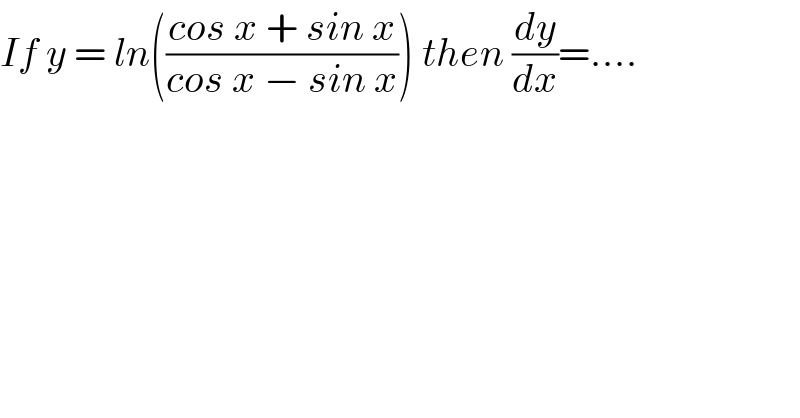
Question Number 125 by novrya last updated on 25/Jan/15

$${If}\:{y}\:=\:{ln}\left(\frac{{cos}\:{x}\:+\:{sin}\:{x}}{{cos}\:{x}\:−\:{sin}\:{x}}\right)\:{then}\:\frac{{dy}}{{dx}}=.... \\ $$
Answered by sushmitak last updated on 07/Dec/14
![Applying chain rule and quotient rule for the cases when cos x−sin x ≠0 and ((cos x+sin x)/(cos x−sin x))>0. (dy/dx) = (((cos x−sin x)/(cos x+sin x)))[(((cos x−sin x)(−sin x+cos x)−(cos x+sin x)(−sin x−cos x))/((cos x−sin x)^2 ))] (dy/dx) = (((cos x−sin x)/(cos x+sin x)))[((−(cos x−sin x)^2 +(cos x+sin x)^2 )/((cos x−sin x)^2 ))] (dy/dx) = (((cos x−sin x)/(cos x+sin x)))[((4sin x cos x)/((cos x−sin x)^2 ))] (dy/dx) = [((4sin x cos x)/((cos x−sin x)(cos x+sin x)))] (dy/dx) = [((4sin x cos x)/((cos^2 x−sin^2 x)))]=((2sin 2x)/(cos 2x)) (dy/dx)=2tan 2x](Q126.png)
$$\mathrm{Applying}\:\mathrm{chain}\:\mathrm{rule}\:\mathrm{and}\:\mathrm{quotient}\:\mathrm{rule}\: \\ $$$$\mathrm{for}\:\mathrm{the}\:\mathrm{cases}\:\mathrm{when}\:\mathrm{cos}\:{x}−\mathrm{sin}\:{x}\:\neq\mathrm{0}\:\mathrm{and} \\ $$$$\frac{\mathrm{cos}\:{x}+\mathrm{sin}\:{x}}{\mathrm{cos}\:{x}−\mathrm{sin}\:{x}}>\mathrm{0}. \\ $$$$\frac{{dy}}{{dx}}\:=\:\left(\frac{\mathrm{cos}\:{x}−\mathrm{sin}\:{x}}{\mathrm{cos}\:{x}+\mathrm{sin}\:{x}}\right)\left[\frac{\left(\mathrm{cos}\:{x}−\mathrm{sin}\:{x}\right)\left(−\mathrm{sin}\:{x}+\mathrm{cos}\:{x}\right)−\left(\mathrm{cos}\:{x}+\mathrm{sin}\:{x}\right)\left(−\mathrm{sin}\:{x}−\mathrm{cos}\:{x}\right)}{\left(\mathrm{cos}\:{x}−\mathrm{sin}\:{x}\right)^{\mathrm{2}} }\right] \\ $$$$\frac{{dy}}{{dx}}\:=\:\left(\frac{\mathrm{cos}\:{x}−\mathrm{sin}\:{x}}{\mathrm{cos}\:{x}+\mathrm{sin}\:{x}}\right)\left[\frac{−\left(\mathrm{cos}\:{x}−\mathrm{sin}\:{x}\right)^{\mathrm{2}} +\left(\mathrm{cos}\:{x}+\mathrm{sin}\:{x}\right)^{\mathrm{2}} }{\left(\mathrm{cos}\:{x}−\mathrm{sin}\:{x}\right)^{\mathrm{2}} }\right] \\ $$$$\frac{{dy}}{{dx}}\:=\:\left(\frac{\mathrm{cos}\:{x}−\mathrm{sin}\:{x}}{\mathrm{cos}\:{x}+\mathrm{sin}\:{x}}\right)\left[\frac{\mathrm{4sin}\:{x}\:\mathrm{cos}\:{x}}{\left(\mathrm{cos}\:{x}−\mathrm{sin}\:{x}\right)^{\mathrm{2}} }\right] \\ $$$$\frac{{dy}}{{dx}}\:=\:\left[\frac{\mathrm{4sin}\:{x}\:\mathrm{cos}\:{x}}{\left(\mathrm{cos}\:{x}−\mathrm{sin}\:{x}\right)\left(\mathrm{cos}\:{x}+\mathrm{sin}\:{x}\right)}\right] \\ $$$$\frac{{dy}}{{dx}}\:=\:\left[\frac{\mathrm{4sin}\:{x}\:\mathrm{cos}\:{x}}{\left(\mathrm{cos}^{\mathrm{2}} {x}−\mathrm{sin}^{\mathrm{2}} {x}\right)}\right]=\frac{\mathrm{2sin}\:\mathrm{2}{x}}{\mathrm{cos}\:\mathrm{2}{x}} \\ $$$$\frac{{dy}}{{dx}}=\mathrm{2tan}\:\mathrm{2}{x} \\ $$
Commented by peter frank last updated on 22/Sep/21

$$\mathrm{great} \\ $$
